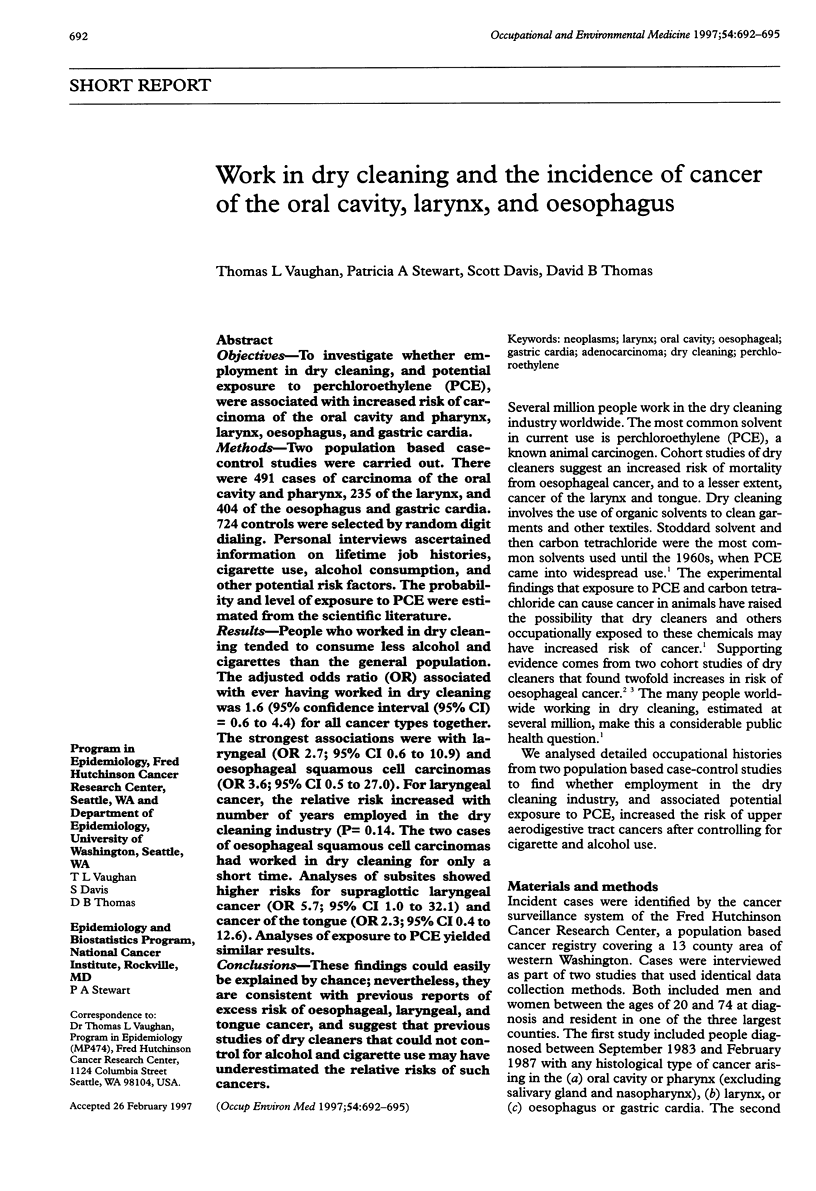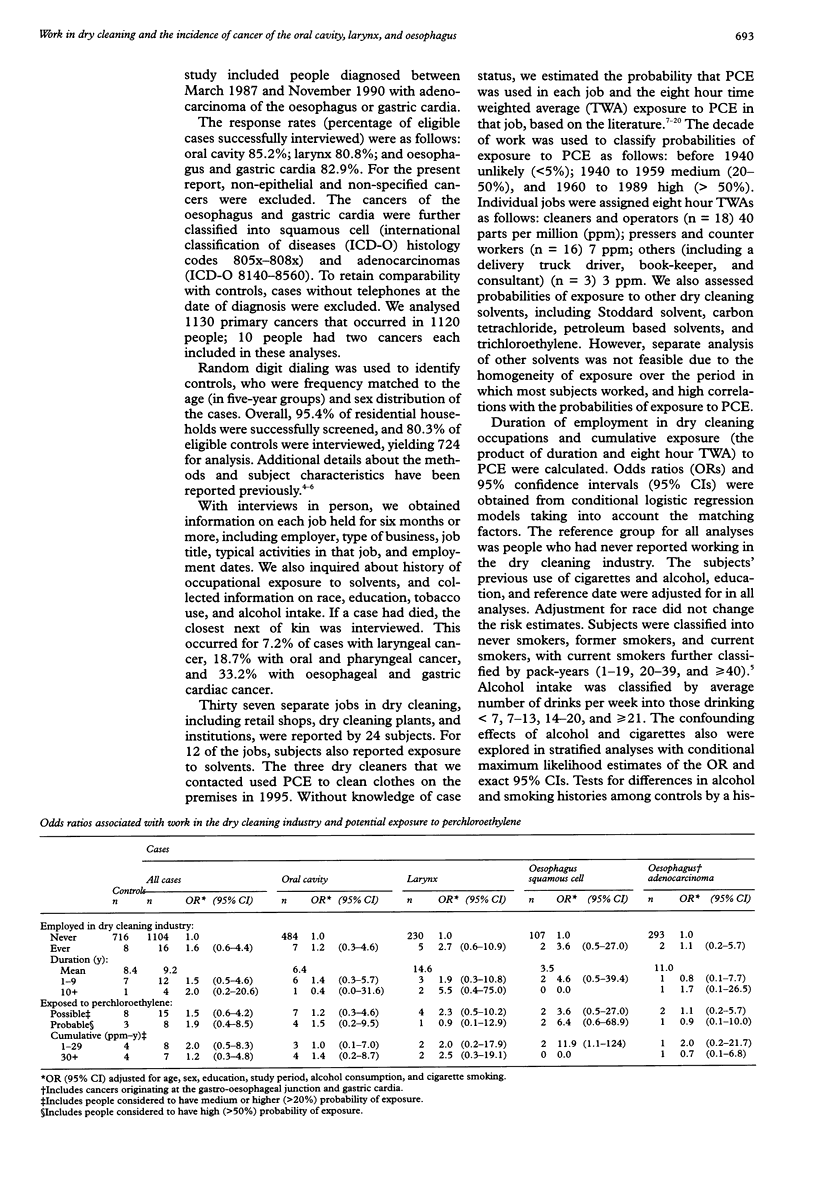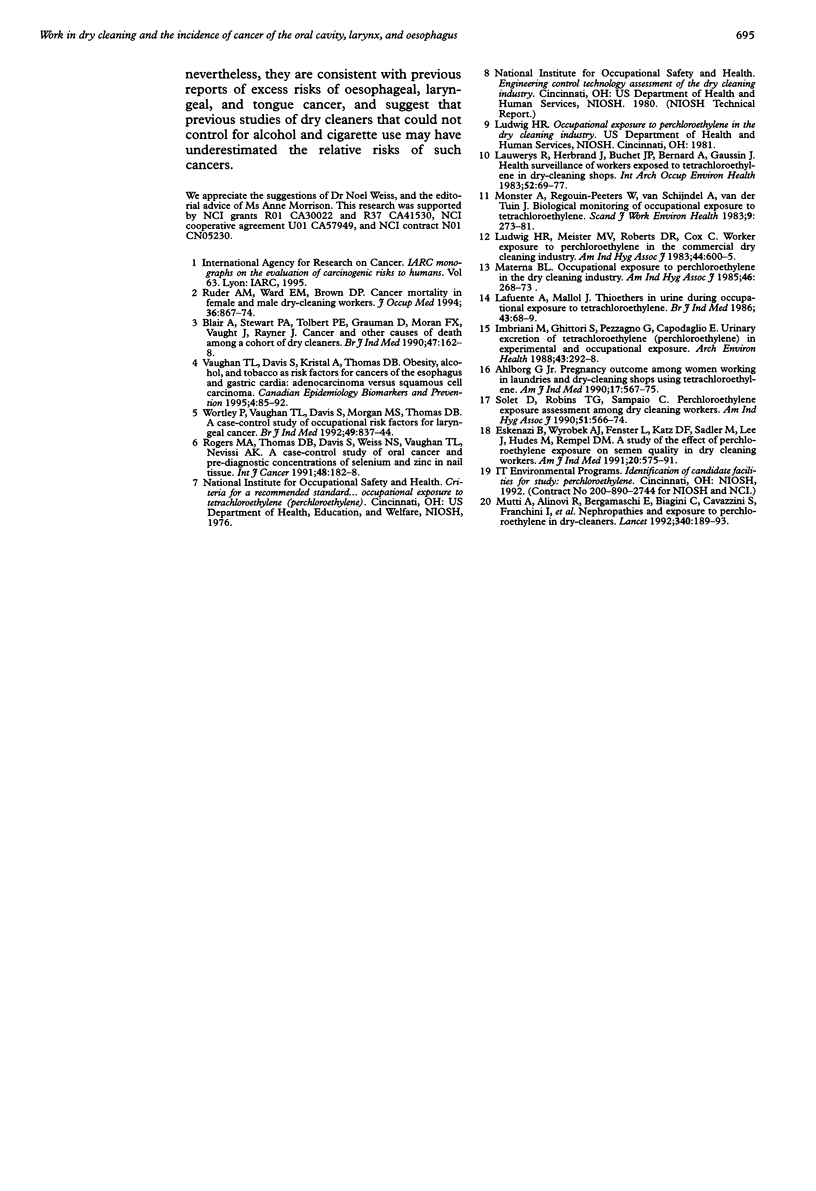Abstract
OBJECTIVES: To investigate whether employment in dry cleaning, and potential exposure to perchloroethylene (PCE), were associated with increased risk of carcinoma of the oral cavity and pharynx, larynx, oesophagus, and gastric cardia. METHODS: Two population based case-control studies were carried out. There were 491 cases of carcinoma of the oral cavity and pharynx, 235 of the larynx, and 404 of the oesophagus and gastric cardia. 724 controls were selected by random digit dialing. Personal interviews ascertained information on lifetime job histories, cigarette use, alcohol consumption, and other potential risk factors. The probability and level of exposure to PCE were estimated from the scientific literature. RESULTS: People who worked in dry cleaning tended to consume less alcohol and cigarettes than the general population. The adjusted odds ratio (OR) associated with ever having worked in dry cleaning was 1.6 (95% confidence interval (95% CI) = 0.6 to 4.4) for all cancer types together. The strongest associations were with laryngeal (OR 2.7; 95% CI 0.6 to 10.9) and oesophageal squamous cell carcinomas (OR 3.6; 95% CI 0.5 to 27.0). For laryngeal cancer, the relative risk increased with number of years employed in the dry cleaning industry (P = 0.14. The two cases of oesophageal squamous cell carcinomas had worked in dry cleaning for only a short time. Analyses of subsites showed higher risks for supraglottic laryngeal cancer (OR 5.7; 95% CI 1.0 to 32.1) and cancer of the tongue (OR 2.3; 95% CI 0.4 to 12.6). Analyses of exposure to PCE yielded similar results. CONCLUSIONS: These findings could easily be explained by chance; nevertheless, they are consistent with previous reports of excess risk of oesophageal, laryngeal, and tongue cancer, and suggest that previous studies of dry cleaners that could not control for alcohol and cigarette use may have underestimated the relative risks of such cancers.
Full text
PDF



Selected References
These references are in PubMed. This may not be the complete list of references from this article.
- Ahlborg G., Jr Pregnancy outcome among women working in laundries and dry-cleaning shops using tetrachloroethylene. Am J Ind Med. 1990;17(5):567–575. doi: 10.1002/ajim.4700170503. [DOI] [PubMed] [Google Scholar]
- Blair A., Stewart P. A., Tolbert P. E., Grauman D., Moran F. X., Vaught J., Rayner J. Cancer and other causes of death among a cohort of dry cleaners. Br J Ind Med. 1990 Mar;47(3):162–168. doi: 10.1136/oem.47.3.162. [DOI] [PMC free article] [PubMed] [Google Scholar]
- Eskenazi B., Wyrobek A. J., Fenster L., Katz D. F., Sadler M., Lee J., Hudes M., Rempel D. M. A study of the effect of perchloroethylene exposure on semen quality in dry cleaning workers. Am J Ind Med. 1991;20(5):575–591. doi: 10.1002/ajim.4700200502. [DOI] [PubMed] [Google Scholar]
- Imbriani M., Ghittori S., Pezzagno G., Capodaglio E. Urinary excretion of tetrachloroethylene (perchloroethylene) in experimental and occupational exposure. Arch Environ Health. 1988 Jul-Aug;43(4):292–298. doi: 10.1080/00039896.1988.10545952. [DOI] [PubMed] [Google Scholar]
- Lafuente A., Mallol J. Thioethers in urine during occupational exposure to tetrachloroethylene. Br J Ind Med. 1986 Jan;43(1):68–69. doi: 10.1136/oem.43.1.68. [DOI] [PMC free article] [PubMed] [Google Scholar]
- Lauwerys R., Herbrand J., Buchet J. P., Bernard A., Gaussin J. Health surveillance of workers exposed to tetrachloroethylene in dry-cleaning shops. Int Arch Occup Environ Health. 1983;52(1):69–77. doi: 10.1007/BF00380609. [DOI] [PubMed] [Google Scholar]
- Ludwig H. R., Meister M. V., Roberts D. R., Cox C. Worker exposure to perchloroethylene in the commercial dry cleaning industry. Am Ind Hyg Assoc J. 1983 Aug;44(8):600–605. doi: 10.1080/15298668391405391. [DOI] [PubMed] [Google Scholar]
- Materna B. L. Occupational exposure to perchloroethylene in the dry cleaning industry. Am Ind Hyg Assoc J. 1985 May;46(5):268–273. doi: 10.1080/15298668591394798. [DOI] [PubMed] [Google Scholar]
- Monster A., Regouin-Peeters W., van Schijndel A., van der Tuin J. Biological monitoring of occupational exposure to tetrachloroethene. Scand J Work Environ Health. 1983 Jun;9(3):273–281. doi: 10.5271/sjweh.2409. [DOI] [PubMed] [Google Scholar]
- Mutti A., Alinovi R., Bergamaschi E., Biagini C., Cavazzini S., Franchini I., Lauwerys R. R., Bernard A. M., Roels H., Gelpi E. Nephropathies and exposure to perchloroethylene in dry-cleaners. Lancet. 1992 Jul 25;340(8813):189–193. doi: 10.1016/0140-6736(92)90463-d. [DOI] [PubMed] [Google Scholar]
- Rogers M. A., Thomas D. B., Davis S., Weiss N. S., Vaughan T. L., Nevissi A. E. A case-control study of oral cancer and pre-diagnostic concentrations of selenium and zinc in nail tissue. Int J Cancer. 1991 May 10;48(2):182–188. doi: 10.1002/ijc.2910480205. [DOI] [PubMed] [Google Scholar]
- Ruder A. M., Ward E. M., Brown D. P. Cancer mortality in female and male dry-cleaning workers. J Occup Med. 1994 Aug;36(8):867–874. [PubMed] [Google Scholar]
- Solet D., Robins T. G., Sampaio C. Perchloroethylene exposure assessment among dry cleaning workers. Am Ind Hyg Assoc J. 1990 Oct;51(10):566–574. doi: 10.1080/15298669091370112. [DOI] [PubMed] [Google Scholar]
- Vaughan T. L., Davis S., Kristal A., Thomas D. B. Obesity, alcohol, and tobacco as risk factors for cancers of the esophagus and gastric cardia: adenocarcinoma versus squamous cell carcinoma. Cancer Epidemiol Biomarkers Prev. 1995 Mar;4(2):85–92. [PubMed] [Google Scholar]


